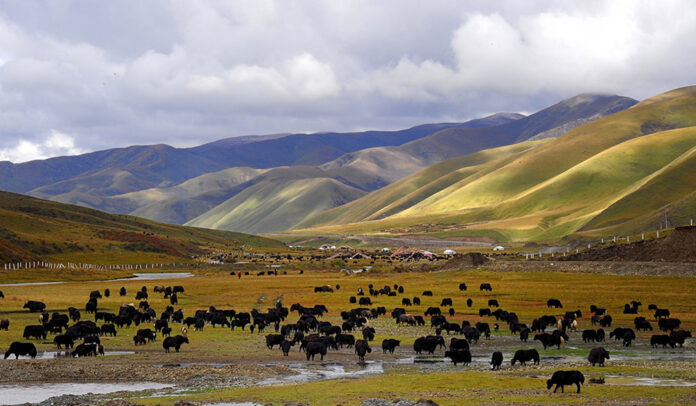(TibetanReview.net, Feb04’21) – A vegetarian movement among resettled nomads has been taking hold in eastern Tibet over the past two decades under the leadership of local Buddhist monks only to be stymied by Chinese immigrant butchers whose business is supported by Chinese authorities through repression of the local population, reported theguardian.com Feb 4. The anti-slaughter movement is declining due to increased surveillance and repression that criminalises Tibetan identity, an anthropologist has said.
Tibetan herders have always eaten meat. In addition to the milk, butter and cheese they derived from yaks, meat was a necessity in their harsh lives. However, a movement spurred by Tibetan Buddhist monks in the region over the past two decades had increasingly urged the now sedentary nomads to practise vegetarianism, to pay a “life ransom” for the release of animals destined for the slaughterhouse, and to abandon the slaughter of their own animals because they had settled down.
However, the “anti-slaughter movement” has put them at odds with local Chinese authorities intent on driving development and the industrial production of yak meat for a Chinese public that is consuming more meat than ever before. The production drive has included the expansion of large numbers of commercial slaughterhouses to process the meat from the approximately 14 million yaks on the Tibetan plateau, the report said.
“My impression is that the [anti-slaughter] movement is declining as a result of increased surveillance and repression that criminalises any movement asserting Tibetan identity,” the report quoted Katia Buffetrille, a French anthropologist and Tibetologist who has been travelling to Tibetan areas for more than three decades, as saying.
Last June 10 Tibetans, including two monks, were jailed for eight to 13 years and fined up to the equivalent of £7,000 each for trying to block the construction of a commercial slaughterhouse in Sangchu County in Gansu province. This largely silenced discussion coming out of Tibetan areas about anti-slaughter beliefs.
The report said the anti-slaughter movement first emerged around 2000 from the Larung Gar Buddhist Academy, famous from photos of its red-roofed shacks dotting a treeless alpine valley in the Garzê region of Sichuan. The spiritual oasis was home to an estimated 40,000 unofficial residents – monks and spirituality seekers – before the extensive destruction of the area and expulsion of a large number of monks since 2016 carried out by the Chinese government.
The academy’s late founder Khenpo Jigme Phuntsok taught against slaughterhouse practices after witnessing them first-hand. He was reported to have said the sight inside slaughterhouses was “similar to what we imagine as the town of death, full of terrifying noises including the sound of machines used to process meat, the sound from sliced throats, the sound of running blood, and moos of livestock in a deadly panic”.
Such scenes were alien to the practices nomads had followed for hundreds of years and would bring bad karma to the Tibetan plateau, he was stated to have taught.
But the campaign to protect animals from industrial-scale slaughter stands in the way of Beijing’s order on local authorities to increase GDP, so that anything that gets in the way challenges state power and authority.
And a three-year, nationwide campaign, launched since 2018 under Xi Jinping’s leadership against “black and evil” forces came as a handy tool to crackdown on the Tibetan movement. Under it local governments in Tibetan regions have increasingly cracked down on anyone organising in those areas outside government sanctioned activities.
Thus, citizen groups trying to protect wildlife or the environment, those calling for increased food safety, religious and cultural activities, and those advocating against land-grabs, the construction of slaughterhouses, or for the freeing of animals as a spiritual practice have all been targeted as “underworld gangs”, the report said, citing organisations that included New York-based Human Rights Watch.
“One of the reasons they cited them as gangs was because they had been organising community members against a slaughterhouse in their home town,” Tenzin Norgay, a research analyst at the Washington-based International Campaign for Tibet, was quoted as saying.
“In some cases they have conflated the anti-slaughter movement with the issue of separatism, so when they pass these kinds of laws it definitely has some impact on the participants in this movement,” he has said.
He has said that since the Jun 2020, he has not heard from people in the region about similar anti-slaughter campaign actions.






